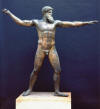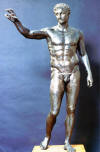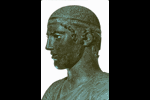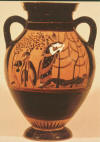The Acropolis (Athens, Greece) "The centerpiece of Pericles'
great building program on the Acropolis was the Parthenon,
or Temple of Athena Parthenos, erected in a remarkably short
period of time between 447 and 438 B.C. ... Two later
temples, the Erechtheion and the Temple of Athena Nike,
built after Pericles' death were probably also part of the
original design. ... That these buildings
exist at all today is something of a miracle. The
Parthenon, for example, was converted into a Byzantine
church and later a Catholic church in the Middle Ages, and
then, after the Ottoman conquest of Greece, into an Islamic
mosque. Each time the building was remodeled for a
different religion it was modified structurally. ...
In 1687 the Venetians besieged the Acropolis, which at that
time was in Turkish hands. One of their rockets scored
a direct hit on the ammunition depot the Turks had installed
in part of the Parthenon. The resultant explosion blew
out the building's center. To make matters worse, the
Venetians subsequently tried to remove some of the statues
from the Parthenon's pediments. In more than one case
statues were dropped and smashed on the ground. Today
... the corrosive emissions of factories and automobiles are
decomposing the ancient marbles. ... Despite the
ravages of time and humanity, most of the Parthenon's
peripteral [external] colonnade is still standing (or has
been reerected), and art historians know a great deal about
the building and its sculptural program. The
architects were Iktinos and Kallikrates."
- Gardner's
Art Through The Ages,
11th edition, Vol. I, pp. 127 - 128

***************************************************
Bronze Statue
- Poseidon or Zeus
"The male human form in
motion is, by contrast, the subject of another Early
Classical bronze statue, which ... divers found in an
ancient shipwreck... off the coast of Greece. The
bearded god once hurled a weapon held in his right hand,
probably a thunderbolt, in which case he is Zeus. A
less likely suggestion is that this is Poseidon with his
trident. The pose could be employed equally well for a
javelin thrower. Both arms are boldly extended, and
the right heel is raised off the ground, underscoring the
lightness and stability of hollow-cast monumental statues."
- Gardner's
Art Through The Ages,
11th edition, Vol. I, pp. 124

Bronze Statue - Paris or Youth from Antikythera

Bronze Statue - The Charioteer (detail) **
"The statue is almost all
that remains of an enormous group. ... The moment chosen for
depiction is not during the frenetic race but after, when
the driver quietly and modestly holds his horses still in
the winner's circle. ... A band inlaid with silver is
tied around the head and confines the hair. The eyes
are made of glass paste and shaded by delicate bronze
lashes."
- Gardner's
Art Through The Ages,
11th edition, Vol. I, p. 123

***************************************************
Amphora - Oenone
and Paris
Greek vase-painting was a
complex process involving layers of glaze and careful
engraving. Originally the earliest ceramics were made
by applying black glaze on red clay resulting in figures
which were black and a red background. Later, artists
traced the figures in the red clay then glazed the
backgrounds black, applying a light line of glaze, resulting
in red figures against a black background. The final
development involved using multiple types of glaze,
post-firing paint, and clay to create polychromatic
(multi-colored) ceramics. Most vases depicted Greek
mythology and were commonly used in all Greek households -
each specific vase type designed to contain a different type
of material (perfume, oil, wine, water, grain, etc.)
This particular vase depicts the grief of Oenone for
deliberately having
let Paris die at her feet.

**************************************************
Overview of Delphi Complex:
Note, from upper right to lower left, the Stadium, the
Amphitheater, and the Temple to Apollo.

Amphitheater
(Delphi, Greece)

Starting
Blocks at the Stadium (Delphi, Greece)

Tholos - Temple to Athena (Delphi ca. 375 B.C.)

|